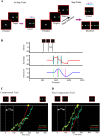Eye-hand coordination during a double-step task: evidence for a common stochastic accumulator
- PMID: 26084906
- PMCID: PMC4556852
- DOI: 10.1152/jn.00276.2015
Eye-hand coordination during a double-step task: evidence for a common stochastic accumulator
Abstract
Many studies of reaching and pointing have shown significant spatial and temporal correlations between eye and hand movements. Nevertheless, it remains unclear whether these correlations are incidental, arising from common inputs (independent model); whether these correlations represent an interaction between otherwise independent eye and hand systems (interactive model); or whether these correlations arise from a single dedicated eye-hand system (common command model). Subjects were instructed to redirect gaze and pointing movements in a double-step task in an attempt to decouple eye-hand movements and causally distinguish between the three architectures. We used a drift-diffusion framework in the context of a race model, which has been previously used to explain redirect behavior for eye and hand movements separately, to predict the pattern of eye-hand decoupling. We found that the common command architecture could best explain the observed frequency of different eye and hand response patterns to the target step. A common stochastic accumulator for eye-hand coordination also predicts comparable variances, despite significant difference in the means of the eye and hand reaction time (RT) distributions, which we tested. Consistent with this prediction, we observed that the variances of the eye and hand RTs were similar, despite much larger hand RTs (∼90 ms). Moreover, changes in mean eye RTs, which also increased eye RT variance, produced a similar increase in mean and variance of the associated hand RT. Taken together, these data suggest that a dedicated circuit underlies coordinated eye-hand planning.
Keywords: drift diffusion; eye-hand coordination; race model; reaction time.
Copyright © 2015 the American Physiological Society.
Figures








Similar articles
-
Computational Mechanisms Mediating Inhibitory Control of Coordinated Eye-Hand Movements.Brain Sci. 2021 May 10;11(5):607. doi: 10.3390/brainsci11050607. Brain Sci. 2021. PMID: 34068477 Free PMC article. Review.
-
A common stochastic accumulator with effector-dependent noise can explain eye-hand coordination.J Neurophysiol. 2015 Apr 1;113(7):2033-48. doi: 10.1152/jn.00802.2014. Epub 2015 Jan 7. J Neurophysiol. 2015. PMID: 25568161 Free PMC article.
-
Evidence of common and separate eye and hand accumulators underlying flexible eye-hand coordination.J Neurophysiol. 2017 Jan 1;117(1):348-364. doi: 10.1152/jn.00688.2016. Epub 2016 Oct 26. J Neurophysiol. 2017. PMID: 27784809 Free PMC article.
-
A common control signal and a ballistic stage can explain the control of coordinated eye-hand movements.J Neurophysiol. 2016 Jun 1;115(5):2470-84. doi: 10.1152/jn.00910.2015. Epub 2016 Feb 17. J Neurophysiol. 2016. PMID: 26888104 Free PMC article.
-
Task context determines whether common or separate inhibitory signals underlie the control of eye-hand movements.J Neurophysiol. 2018 Oct 1;120(4):1695-1711. doi: 10.1152/jn.00085.2018. Epub 2018 Jun 20. J Neurophysiol. 2018. PMID: 29924711
Cited by
-
Anticipatory Postural Adjustments associated with reaching movements are programmed according to the availability of visual information.Exp Brain Res. 2017 May;235(5):1349-1360. doi: 10.1007/s00221-017-4898-3. Epub 2017 Feb 17. Exp Brain Res. 2017. PMID: 28213690
-
Abnormalities of Eye-Hand Coordination in Patients with Writer's Cramp: Possible Role of the Cerebellum.Tremor Other Hyperkinet Mov (N Y). 2017 Oct 9;7:499. doi: 10.7916/D8Z89QW7. eCollection 2017. Tremor Other Hyperkinet Mov (N Y). 2017. PMID: 29109905 Free PMC article.
-
Computational Mechanisms Mediating Inhibitory Control of Coordinated Eye-Hand Movements.Brain Sci. 2021 May 10;11(5):607. doi: 10.3390/brainsci11050607. Brain Sci. 2021. PMID: 34068477 Free PMC article. Review.
-
Corrective response times in a coordinated eye-head-arm countermanding task.J Neurophysiol. 2018 Jun 1;119(6):2036-2051. doi: 10.1152/jn.00460.2017. Epub 2018 Feb 21. J Neurophysiol. 2018. PMID: 29465326 Free PMC article.
-
Different decision deficits impair response inhibition in progressive supranuclear palsy and Parkinson's disease.Brain. 2016 Jan;139(Pt 1):161-73. doi: 10.1093/brain/awv331. Epub 2015 Nov 18. Brain. 2016. PMID: 26582559 Free PMC article.
References
-
- Aslin RN, Shea SL. The amplitude and angle of saccades to double-step target displacements. Vision Res 27: 1925–1942, 1987. - PubMed
-
- Becker W, Jürgens R. An analysis of the saccadic system by means of double step stimuli. Vision Res 19: 967–983, 1979. - PubMed
-
- Bekkering H, Adam JJ, Kingma H, Huson A, Whiting H. Reaction time latencies of eye and hand movements in single-and dual-task conditions. Exp Brain Res 97: 471–476, 1994. - PubMed
-
- Biguer B, Jeannerod M, Prablanc C. The coordination of eye, head, and arm movements during reaching at a single visual target. Exp Brain Res 46: 301–304, 1982. - PubMed
-
- Bizzi E, Kalil RE, Tagliasco V. Eye-head coordination in monkeys: evidence for centrally patterned organization. Science 173: 452–454, 1971. - PubMed
Publication types
MeSH terms
LinkOut - more resources
Full Text Sources
Other Literature Sources

